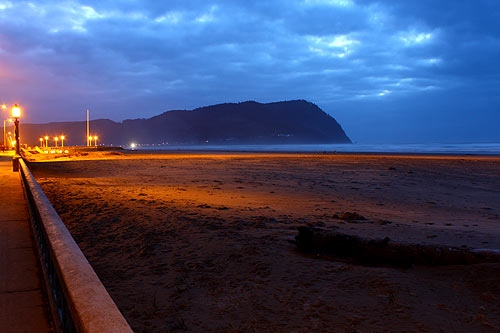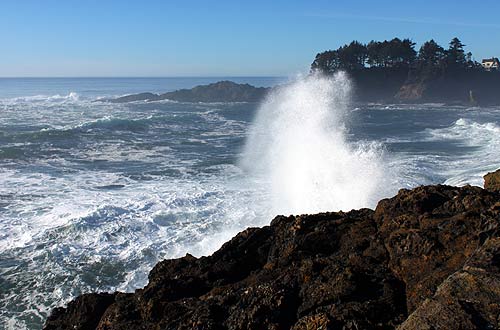Wacky Weather Facts About the Oregon Coast
Published 12/07/2010

(Oregon Coast) – If you're looking for a little more daytime in winter, maybe a chance at a good suntan by the sea, or searching for a strong burst of spring weather in February, the coast will surprise you (above: a dry but chilly November dusk in Seaside).
It’s all proof you need to spend more time looking at the actual, real time weather conditions of the coast, including the web cams and live weather in places like Newport, Lincoln City, Seaside or Cannon Beach, and especially the Depoe Bay weather page and web cam.
Some surprises lurk there, and in the following paragraphs.

Sunset Ten Minutes Later Than Inland. If you want a slightly longer day, especially during these dark days near the winter solstice, then head to the coast. There, sundown happens about ten minutes later than the Portland area or Willamette Valley, because of the mountain range between the valley and the western edge of the continent. And then sunset watchers on the coast see it from the lowest possible elevation: at seal level.

Those Puzzling Warmer Days on the Beach. One aspect of these beaches that’s more than a little surprising is how, at times, the temperature can be quite cold, and yet you feel very warm while on the sand.
It turns out, according to KOIN 6-TV weatherman Bruce Sussman, the sun reflects off the ocean and can warm things up considerably. On sunny days, especially if there’s little to no wind, the beach can seem a very warm place. You can head just a few miles inland – or maybe even less than half a mile – and you definitely feel a chill. But on the sand, it’s much warmer.
During those famous "Second Summer" days of September and early October, the streets of towns like Lincoln City, Seaside, Cannon Beach or Newport can sometimes be fairly cool and fall-like, but head to the sand and you’re cooking.
It takes the right conditions for this, including blue skies and no wind, but it's rather extraordinary when it occurs.
This is one reason that suntan lotion is so important on nice, sunny days on the coast: this reflecting action off the water heightens the chance of a sunburn.

Coast Warmer Than Inland in Winter. Many in Oregon associate the coast with primarily colder, wetter weather – but that’s an argument better left to another article, as that may not be essentially correct. Yet while its winters are harsher in terms of stormy downpours and heavy winds, it’s actually considerably warmer on the coast than spots like Portland, Salem or Eugene during many winter days.
Includes exclusive listings; some specials in winter
In Cannon Beach:
Includes rentals not listed anywhere else
In Manzanita, Wheeler, Rockaway Beach:
Some specials for winter
In Pacific City, Oceanside:
Some specials for winter
In Lincoln City:
Some specials for winter
In Depoe Bay, Gleneden Beach:
Some specials for winter
In Newport:
Look for some specials
In Waldport
Some specials for winter
In Yachats, Florence
Some specials for winter
True, heavy winds give the place a nastier chill factor, and it gets windy more often, but the ocean has a major moderating influence on the temperature of the shoreline. That keeps the temperature range rather small. Winter features days often in the 50’s and nights in the 40’s – not a big swing in temperature.
In fact, in December, January and February, you’ll find temperatures often much warmer than the inland portion of Oregon, if that area is experiencing a chill. Yes, it snows on the coast sometimes; but mostly, if Portland or Eugene are in the 30’s or lower, you won’t find the coast getting much lower than 35 degrees. Also, snow events on the coast are much rarer, so there can be sizable snow storms along the I-5 corridor, but no such flakes falling on the coast.
This moderating effect from the ocean has quite a reach. Many locals will boast how the coast is not only often warmer than the valley in December, but that month can be warmer than June along the beaches at times.
Another interesting proof of this occurred just recently – in early December - when Portland and the valley were hit with heavy winds and exceptionally chilly temperatures. Meanwhile, the coast was basking in the 50’s, albeit under gray skies. Paradoxically, that area experienced very little winds, while Portland was getting hammered. This was a curious flip-flop, for a change.
Statistics, such as those in weather almanacs or on the Hatfield Marine Science Center's rain summaries website, also show that the coast doesn’t experience a lot more rainy days than inland Oregon. It’s often roughly the same, as both areas frequently share the same weather patterns and systems. So, a dry overcast day in Woodburn or Wilsonville probably means it’s similar on the coast – much of the time.
Come February, there can be an enormous, marked difference between the coast and Portland, as the coast basks in glorious sun and blue skies in what is nicknamed “the secret spring.” Due to longer days heating up the land and ocean more, and a shift in the season towards more dry, spring-like conditions, both inland Oregon and the coast will start to experience a decent run of sunnier days. But inland, it’s frequently winter-like and chilly, near freezing at times. But on the coast, because of the temperate influence of the ocean, you get as many as 14 days of extremely warm, dry days with little or no wind.
It doesn’t happen every February of every year, but it is rather typical to have this month filled with a good number of shockingly warm, lovely days on the beach. Oregon Coast Hotels for this - Where to eat - Maps - Virtual Tours
Cannon Beach Lodging
Nehalem Bay Lodgings
Manzanita Hotels, Lodging
Three Capes Lodging
Pacific City Hotels, Lodging
Lincoln City Lodging
Depoe Bay Lodging
Newport Lodging
Waldport Lodging
Yachats Lodging
Oregon Coast Vacation Rentals
Oregon Coast Lodging Specials

More About Oregon Coast hotels, lodging.....
More About Oregon Coast Restaurants, Dining.....
LATEST Related Oregon Coast Articles
Likely just before dawn best hour but peak happens during daylight. Weather
Dark Sky Week is Prime Along Oregon Coast: Where and Where Not to Go
General guide to dark sky viewing from south to north coast. Astronomy
Sizable Price Drop, Deals in Lincoln City During Quiet of April on Central Or...
20 perc off at A1 Vacation Rentals across its roster, including Gleneden Beach. Lincoln City specials
Upcoming S. Oregon Coast Events Include Gem Show, History: Coos Bay, Bandon
May 6 talk at Coos History Museum, Mayfly Fest May 17, Bandon Rock / Gem Show June 7,8
Washington Coast Cleanup on April 19 - Coinciding with Oregon Coast's SOLVE E...
From the Puget Sound to Long Beach, alongside Oregon's cleanup. Washington coast events, Seaside events
Astoria's Riverwalk Gets New Lighting, More N. Oregon Coast Roadwork
Delays coming this summer, but the riverwalk has a new look. Seaside, Cannn Beach
April Gets Even Cheaper Midweek at Depoe Bay, Lincoln City: Oregon Coast Deals
Off-season rates plus more at Keystone Vacation Rentals. Depoe Bay lodging specials, Lincoln City hotel reviews, Newport hotel reviews
Washington Coast Begins Week of Clam Digs, April 12 Through 18
Long Beach, Twin Harbors, Mocrocks and Copalis at different times. Washington coast events
Back to Oregon Coast
Contact Advertise on BeachConnection.net
All Content, unless otherwise attributed, copyright BeachConnection.net Unauthorized use or publication is not permitted














































